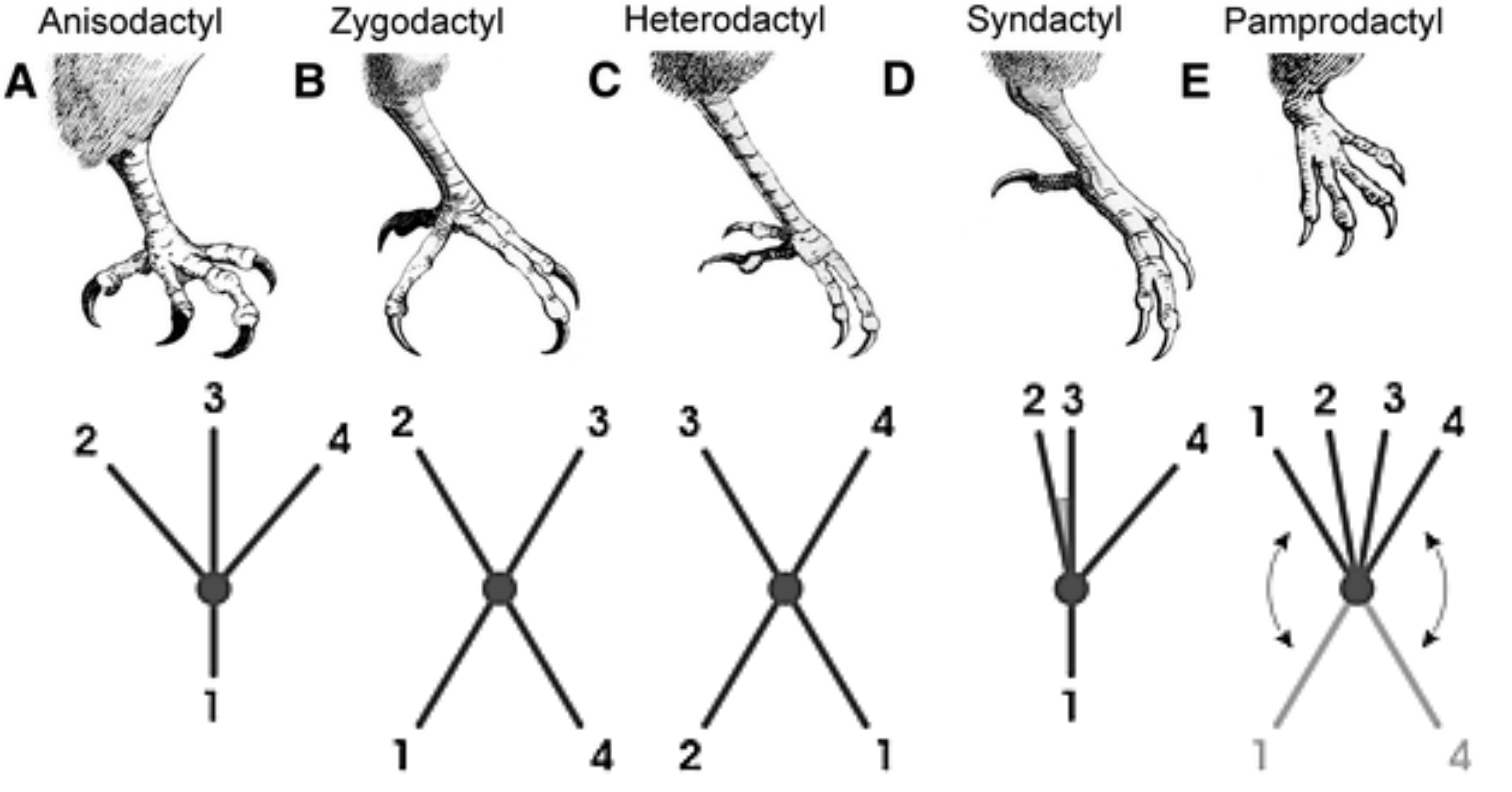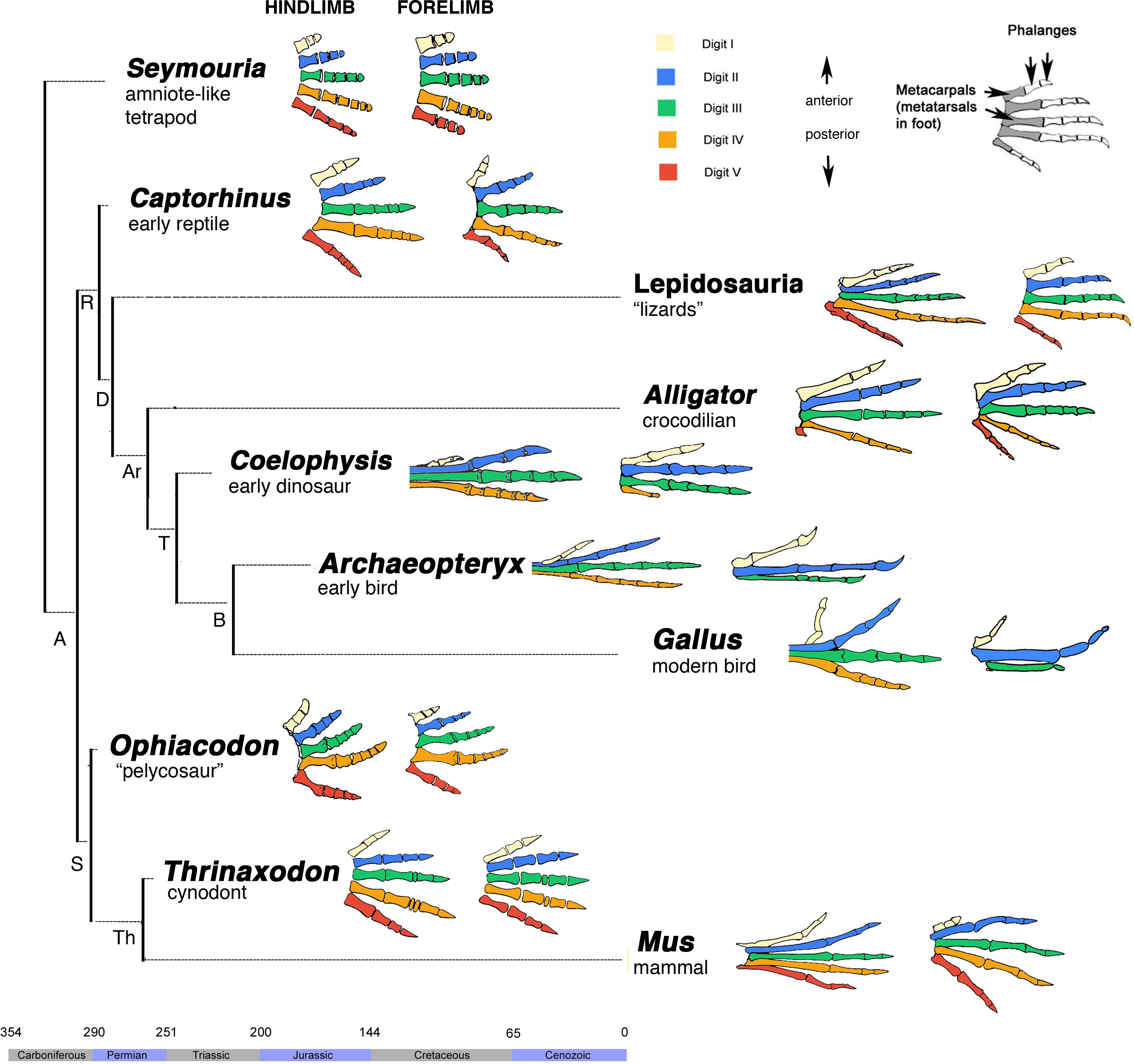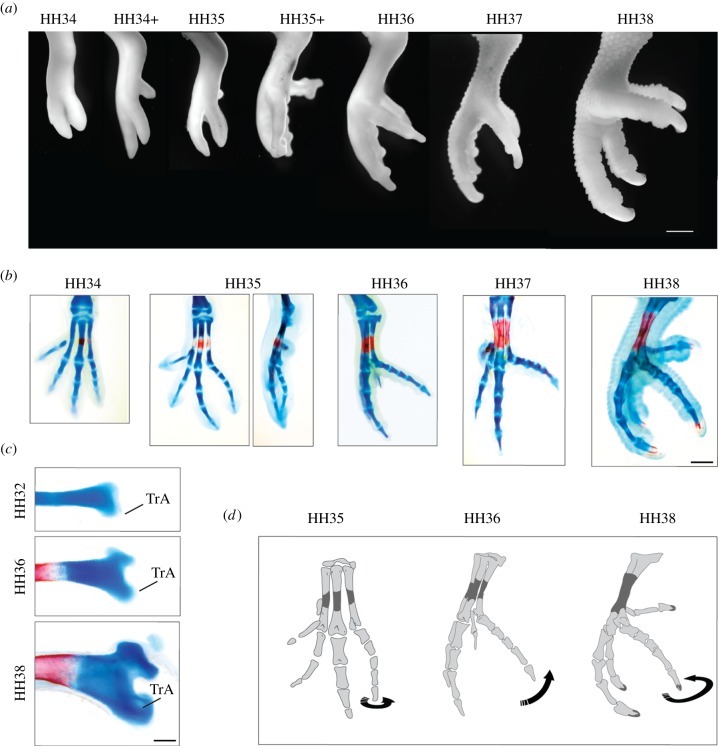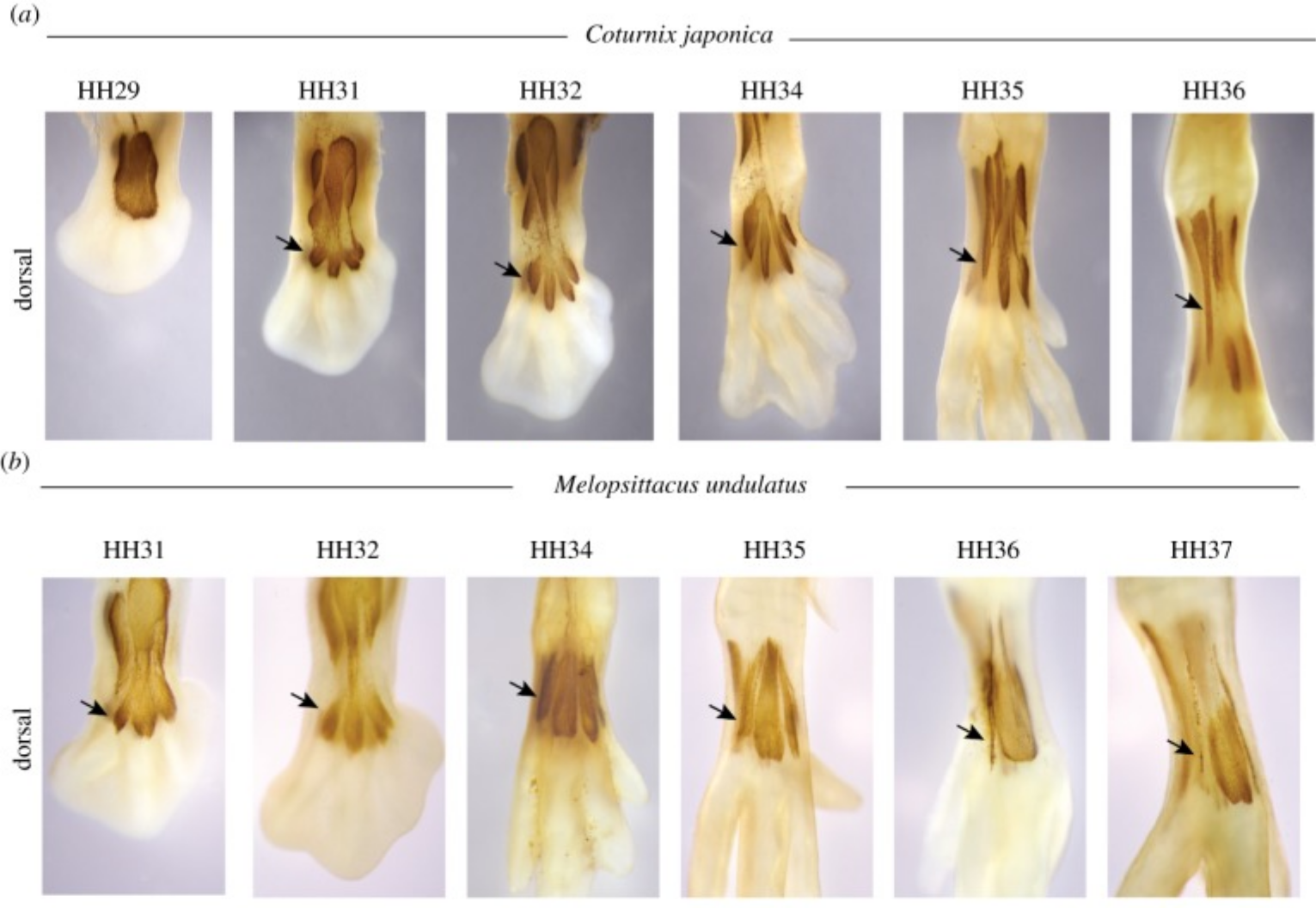10.2: Bird Dactyly
- Page ID
- 20788
\( \newcommand{\vecs}[1]{\overset { \scriptstyle \rightharpoonup} {\mathbf{#1}} } \)
\( \newcommand{\vecd}[1]{\overset{-\!-\!\rightharpoonup}{\vphantom{a}\smash {#1}}} \)
\( \newcommand{\dsum}{\displaystyle\sum\limits} \)
\( \newcommand{\dint}{\displaystyle\int\limits} \)
\( \newcommand{\dlim}{\displaystyle\lim\limits} \)
\( \newcommand{\id}{\mathrm{id}}\) \( \newcommand{\Span}{\mathrm{span}}\)
( \newcommand{\kernel}{\mathrm{null}\,}\) \( \newcommand{\range}{\mathrm{range}\,}\)
\( \newcommand{\RealPart}{\mathrm{Re}}\) \( \newcommand{\ImaginaryPart}{\mathrm{Im}}\)
\( \newcommand{\Argument}{\mathrm{Arg}}\) \( \newcommand{\norm}[1]{\| #1 \|}\)
\( \newcommand{\inner}[2]{\langle #1, #2 \rangle}\)
\( \newcommand{\Span}{\mathrm{span}}\)
\( \newcommand{\id}{\mathrm{id}}\)
\( \newcommand{\Span}{\mathrm{span}}\)
\( \newcommand{\kernel}{\mathrm{null}\,}\)
\( \newcommand{\range}{\mathrm{range}\,}\)
\( \newcommand{\RealPart}{\mathrm{Re}}\)
\( \newcommand{\ImaginaryPart}{\mathrm{Im}}\)
\( \newcommand{\Argument}{\mathrm{Arg}}\)
\( \newcommand{\norm}[1]{\| #1 \|}\)
\( \newcommand{\inner}[2]{\langle #1, #2 \rangle}\)
\( \newcommand{\Span}{\mathrm{span}}\) \( \newcommand{\AA}{\unicode[.8,0]{x212B}}\)
\( \newcommand{\vectorA}[1]{\vec{#1}} % arrow\)
\( \newcommand{\vectorAt}[1]{\vec{\text{#1}}} % arrow\)
\( \newcommand{\vectorB}[1]{\overset { \scriptstyle \rightharpoonup} {\mathbf{#1}} } \)
\( \newcommand{\vectorC}[1]{\textbf{#1}} \)
\( \newcommand{\vectorD}[1]{\overrightarrow{#1}} \)
\( \newcommand{\vectorDt}[1]{\overrightarrow{\text{#1}}} \)
\( \newcommand{\vectE}[1]{\overset{-\!-\!\rightharpoonup}{\vphantom{a}\smash{\mathbf {#1}}}} \)
\( \newcommand{\vecs}[1]{\overset { \scriptstyle \rightharpoonup} {\mathbf{#1}} } \)
\( \newcommand{\vecd}[1]{\overset{-\!-\!\rightharpoonup}{\vphantom{a}\smash {#1}}} \)
\(\newcommand{\avec}{\mathbf a}\) \(\newcommand{\bvec}{\mathbf b}\) \(\newcommand{\cvec}{\mathbf c}\) \(\newcommand{\dvec}{\mathbf d}\) \(\newcommand{\dtil}{\widetilde{\mathbf d}}\) \(\newcommand{\evec}{\mathbf e}\) \(\newcommand{\fvec}{\mathbf f}\) \(\newcommand{\nvec}{\mathbf n}\) \(\newcommand{\pvec}{\mathbf p}\) \(\newcommand{\qvec}{\mathbf q}\) \(\newcommand{\svec}{\mathbf s}\) \(\newcommand{\tvec}{\mathbf t}\) \(\newcommand{\uvec}{\mathbf u}\) \(\newcommand{\vvec}{\mathbf v}\) \(\newcommand{\wvec}{\mathbf w}\) \(\newcommand{\xvec}{\mathbf x}\) \(\newcommand{\yvec}{\mathbf y}\) \(\newcommand{\zvec}{\mathbf z}\) \(\newcommand{\rvec}{\mathbf r}\) \(\newcommand{\mvec}{\mathbf m}\) \(\newcommand{\zerovec}{\mathbf 0}\) \(\newcommand{\onevec}{\mathbf 1}\) \(\newcommand{\real}{\mathbb R}\) \(\newcommand{\twovec}[2]{\left[\begin{array}{r}#1 \\ #2 \end{array}\right]}\) \(\newcommand{\ctwovec}[2]{\left[\begin{array}{c}#1 \\ #2 \end{array}\right]}\) \(\newcommand{\threevec}[3]{\left[\begin{array}{r}#1 \\ #2 \\ #3 \end{array}\right]}\) \(\newcommand{\cthreevec}[3]{\left[\begin{array}{c}#1 \\ #2 \\ #3 \end{array}\right]}\) \(\newcommand{\fourvec}[4]{\left[\begin{array}{r}#1 \\ #2 \\ #3 \\ #4 \end{array}\right]}\) \(\newcommand{\cfourvec}[4]{\left[\begin{array}{c}#1 \\ #2 \\ #3 \\ #4 \end{array}\right]}\) \(\newcommand{\fivevec}[5]{\left[\begin{array}{r}#1 \\ #2 \\ #3 \\ #4 \\ #5 \\ \end{array}\right]}\) \(\newcommand{\cfivevec}[5]{\left[\begin{array}{c}#1 \\ #2 \\ #3 \\ #4 \\ #5 \\ \end{array}\right]}\) \(\newcommand{\mattwo}[4]{\left[\begin{array}{rr}#1 \amp #2 \\ #3 \amp #4 \\ \end{array}\right]}\) \(\newcommand{\laspan}[1]{\text{Span}\{#1\}}\) \(\newcommand{\bcal}{\cal B}\) \(\newcommand{\ccal}{\cal C}\) \(\newcommand{\scal}{\cal S}\) \(\newcommand{\wcal}{\cal W}\) \(\newcommand{\ecal}{\cal E}\) \(\newcommand{\coords}[2]{\left\{#1\right\}_{#2}}\) \(\newcommand{\gray}[1]{\color{gray}{#1}}\) \(\newcommand{\lgray}[1]{\color{lightgray}{#1}}\) \(\newcommand{\rank}{\operatorname{rank}}\) \(\newcommand{\row}{\text{Row}}\) \(\newcommand{\col}{\text{Col}}\) \(\renewcommand{\row}{\text{Row}}\) \(\newcommand{\nul}{\text{Nul}}\) \(\newcommand{\var}{\text{Var}}\) \(\newcommand{\corr}{\text{corr}}\) \(\newcommand{\len}[1]{\left|#1\right|}\) \(\newcommand{\bbar}{\overline{\bvec}}\) \(\newcommand{\bhat}{\widehat{\bvec}}\) \(\newcommand{\bperp}{\bvec^\perp}\) \(\newcommand{\xhat}{\widehat{\xvec}}\) \(\newcommand{\vhat}{\widehat{\vvec}}\) \(\newcommand{\uhat}{\widehat{\uvec}}\) \(\newcommand{\what}{\widehat{\wvec}}\) \(\newcommand{\Sighat}{\widehat{\Sigma}}\) \(\newcommand{\lt}{<}\) \(\newcommand{\gt}{>}\) \(\newcommand{\amp}{&}\) \(\definecolor{fillinmathshade}{gray}{0.9}\)Birds are in the class Aves. They evolved from theropod dinosaurs and the first fossil bird discovered was Archaeopteryx. A few characteristics that make an animal a bird include wings, toothless beaks, and feathers. Bird feet have four digits but these can can be arranged in different ways. The most common digit arrangement is three in the front and one in the back as seen in perching birds and raptors like the Savanna Hawk (Figure 1). The difference between the perching food and the raptor foot is not in the digit layout but in the claws. In the raptor foot, the claws are more curved. They can also have two in the front and two in the back as seen with the grasping bird in the image. Another variation in bird feet is webbed digits which occur in swimming birds like ducks.

There are a few different digit arrangements commonly seen in bird feet (Figure 2) . This most-common arrangement is called anisodactyly. It is where digits 2, 3,and 4 face anteriorly and the hallux faces posteriorly (Figure 2). Syndactyl feet have the same arrangement as anisodactyl, but digits 2, 3, and 4 are encased by skin, this is seen in kingfisher feet (Figure1). There are also more extreme cases of webbing, especially in ducks and other water-fowl. A zygodactyl foot is when two digits, 2 and 3, are facing anteriorly and they other two digits, 1 and 4 are facing posteriorly, one example of this is in cuckoos and owls (Figure 1). A heterodactyl foot is similar to a zygodactyl foot but digits 3 and 4 face anteriorly and digits 1 and 2 face posteriorly, this foot is very rare and only seen in trogons (Figure 1). And finally a pamprodactyl foot is when digits 1 and 4 can rotate so that all four digits can face anteriorly. Mousebirds and swifts are famous for their pamprodactyl feet (Figure 2). When their digits face the same way, swifts (not pictured) are able to use them as hooks.
 |
Figure 2: Digit arrangements in bird feet. Top panel shows line drawings of bird feet from Bothelo et al, 2015. Used with permission. Bottom panel shows a "footprint" of each of the different types of feet with digits numbered. Bottom panel from Wikimedia commons (Darekk2) and originally published under a CC-BY-SA 3.0 license. |
Birds arose from therapod dinosaurs with 4 toed feet (Figure 3). The anisodactyl foot formed when the hallux was rotated posteriorly. It also used to be slightly elevated and smaller than the other digits. It is now no longer elevated and longer than the second digit. This resulted in digits 2, 3, and 4 facing anteriorly and digit 1 posteriorly as shown in the previous images. This is a modified version of the ancestral foot with few changes. The zygodactyl foot formed when both digits 1 and 4 rotated posteriorly (Figure 4). This is a more drastic change than the anisodactyl foot.
 |
Figure 3: The evolution of digit morphology. Left panel: Homologous digits are color coded. Forelimbs are on the right and Hindlimbs are on the left. Most vertebrates have five digits on each autopod, but the reptile lineage shows asymmetric digit loss. Birds, like Archaeopteryx and chick (Gallus gallus) have four digits on their hindlimbs and three in their wings. Within the bird lineage different digit arrangements have evolved. Image from Vargas et al, 2008 published under a CC BY license. Right panel: the evolution of digit arrangements within the bird lineage. The order in which each type of dactyly evolved is unknown and at least one has evolved multiple times. Figure by Jessica Niccum, Alexis Amador, and Ajna Rivera
Botelho et al (2014) examined the development of the zygodactyl foot seen in birds like budgies. In this study, they found that in the beginning stages, budgerigars had similar development to that of a chicken (which has anisodactyl feet). Unlike chickens, however, after about 35 hours, the fourth digit rotated medio- laterally. After 36 hours, the fourth digit became flexed resembling a semi-zygodactyl foot, like owls have. After 37 hours, the fourth digit further rotated to resemble zygodactyl foot orientation (Figure 4). This suggests that digit rotation near the end of foot development is responsible for the evolution of zygodactyly, and zygodactyl feet do not grow digits in a new location. Because of this late-stage difference, the researchers examined the possibility that muscle formation and activation was responsible for digit rotation.
 |
Figure 4: Development of a zygodactyl foot. A. External anatomy of a developing budgerigar foot at successive stages (HHXX). B. Skeletal structures in budgerigar foot development, cartilage is stained blue and bones are red. C. TrA is trochlea accessoria, the distal tip of metatarsal 4 The hook shape seen at HH38 is characteristic of zygodactyl birds. D. Diagram of the change in digit 4 orientation during development. Figure from Botehlo et al 2014. Used with permission. |
Much of the development of various digit conformations is tied to the development of muscle formation and activation in the early stages. In anisodactyl feet, both EBDIV and ABDIV (extensor and adductor brevis muscles) are well developed. In zygodactyly such as budgies, however, the EBDIV is almost completely absent. The researchers found that the EBDIV becomes reduced when it separates from the other muscles in zygodactyl feet. The ABDIV, however, is well developed. The ABDIV causes the flexion of the 4th digit. This flexion combined with the constraint from EBDIV results in the zygodactyl orientation (Figures 4 and 5).
 |
Figure 5: Anisodactyl vs. zygodactyl foot development. A. Shows the development of a quail foot while B. Shows the development of a budgerigar foot. Brown is antibody staining against myosin2, which is found in muscles. Arrows point out the musculus extensor brevis digiti 4, which degenerates in the budgerigar and allows the musculus abductor digiti 4 to pull the fourth digit medio-laterally. Figure from Botelho et al, 2014. Used with permission. |
To our knowledge, development of other bird hindlimb digit confirmations haven’t been studied. Based on what we know about anisodactyl and zygodactyl foot development, we hypothesize a similar evolutionary and developmental trajectory for heterodactyl feet. The Heterodactyl foot looks similar to the Zygodactyl foot but digit 2 is rotated instead of digit 4. We think the development could be the same as the Zygodactyl foot but the muscular changes affect the 2nd digit. Trogon birds have heterodactyl feet (Figures1 and 2). They have two digits anteriorly, digits 3 and 4, and two posteriorly, digits 1 and 2.
Syndactyl feet, like those of kingfishers (Figure 1) have fusion of two digits via webbing. Under this webbing, they have the same digit conformation as anisodactyl feet. Research on bat wings has shown that the webbing between the digits is due to expression of a Bmp antagonist. In other animals like mice, Bmps cause the death of the interdigital mesenchyme. So, a Bmp antagonist in syndactyl birds could potentially prevent the apoptosis of the mesenchyme surrounding the digits, leading to syndactyl feet.
References
Botelho, J.F., Smith-Paredes, D. & Vargas, A.O. (2015) “Altriciality and the Evolution of Toe Orientation in Birds” Evol Biol 42: 502. https://doi.org/10.1007/s11692-015-9334-7
Alexander O. Vargas , Tiana Kohlsdorf, John F. Fallon, John VandenBrooks, Günter P. Wagner (2008) “The Evolution of HoxD-11 Expression in the Bird Wing: Insights from Alligator mississippiensis” PLoS ONE 3(10): e3325. https://doi.org/10.1371/journal.pone.0003325
João Francisco Botelho, Daniel Smith-Paredes, Daniel Nuñez-Leon, Sergio Soto-Acuña, Alexander O. Vargas (2014) “The developmental origin of zygodactyl feet and its possible loss in the evolution of Passeriformes” Proc Biol Sci 281(1788):20140765. doi: 10.1098/rspb.2014.0765
Scott D. Weatherbee, Richard R. Behringer, John J. Rasweiler, Lee A.Niswander (2006) "Interdigital webbing retention in bat wings illustrates genetic changes underlying amniote limb diversification" Proceedings of the National Academy of Sciences 103 (41) 15103-15107; DOI:10.1073/pnas.0604934103


